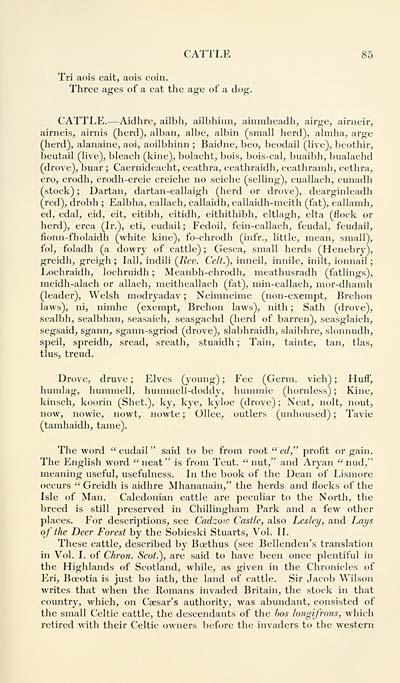Download files
Complete book:
Individual page:
Thumbnail gallery: Grid view | List view

CATTLE 8S
Tri aois cait, aois coin.
Three ases of a cat the ase of a doff.
CATTLE. — Aidhre, ailbli. ailbhinn, ammheadh, airge, ainieir,
aii'iieis, airnis (herd), alban, albe^ albin (small herd), almha, arge
(herd), alanaiue, aoi, aoilbhinn ; Baidne, beo, beodail (live), l)eothir,
beutail (live), bleach (kine), bolacht, bois, bois-cal, buaibh, l)ualachd
(drove), buar ; Caernideacht, ceathra, ceathraidh, ceathranih, cethra,
cro, crodh, crodh-creic creiche no seiche (selling), cuallach, cunadh
(stock) ; Dartan, dartan-eallaigh (herd or drove), dearginleadh
(red), drobh ; Ealbha, eallach, eallaidh, eallaidh-meith (fat), eallamh,
ed, edal, eid, eit, eitibh, eitidh, eithithibh, eltlagh, elta (flock or
hei'd), erca (Ir.), eti, eudail ; Fedoil, fein-eallach, feudal, feudail,
fionn-fholaidh (white kine), fo-chrodh (infr., little, mean, small),
fol, foladh (a dowry of cattle); Gesca, small herds (Henebry),
greidh, greigh ; lall, indili (^liev. Celt.^, inneil, innile, inilt, ionnail ;
Lochraidh, iochruidh ; Meanbh-chrodh, meathusradh (fatlings),
meidh-alach or allach, meitheallach (fat), min-eallach, mor-dhamh
(leader), Welsh modryadav ; Neimneime (non-exempt, Brehon
laws), ni, nimhe (exempt, Brehon laws), nith ; Sath (drove),
sealbh, sealbhan, seasaich, seasgachd (herd of barren), seasglaich,
segsaid, sgann, sgann-sgriod (drove), slabhraidh, slaibhre, slonnudh,
speil, spreidh, sread, sreath, stuaidh ; Tain, tainte, tan, tlas,
tlus, treud.
Drove, druve ; Elves (young) ; Fee (Germ, vich) ; Huff,
humlag, hummell, hummell-doddy, hummie (hornless) ; Kine,
kinsch, koorin (Shet.), ky, kye, kyloe (drove) ; Neat, nolt, nout,
now, nowie, nowt, nowte ; Ollee, outlers (unhoused) ; Tavie
(tamhaidh, tame).
The word "eudail" said to be from root"«/," profit or gain.
The English word "neat" is from Teut. "nut," and Aryan "nud,"
meaning useful, usefulness. In the book of the Dean of Lismore
occurs " Greidh is aidhre Mhananain," the herds and flocks of the
Isle of Man. Caledonian cattle are peculiar to the North, the
breed is still preserved in Chillingham Park and a few other
places. For descriptions, see Cadzoir Castle, also Lesley, and Lays
of the Deer Forest by the Sobieski Stuarts, Vol. II.
These cattle, described by Baethus (see Bellenden's translation
in Vol. I. of Chron. Scot.), are said to have been once plentiful in
the Highlands of Scotland, while, as given in the Chronicles of
Eri, Boeotia is just bo iath, the land of cattle. Sir Jacob Wilson
writes that when the Romans invaded Britain, the stock in that
country, -which, on Caesar's authority, was abundant, consisted of
the small Celtic cattle, the descendants of the bos longifrons, which
retired with their Celtic owners before the invaders to the western
Tri aois cait, aois coin.
Three ases of a cat the ase of a doff.
CATTLE. — Aidhre, ailbli. ailbhinn, ammheadh, airge, ainieir,
aii'iieis, airnis (herd), alban, albe^ albin (small herd), almha, arge
(herd), alanaiue, aoi, aoilbhinn ; Baidne, beo, beodail (live), l)eothir,
beutail (live), bleach (kine), bolacht, bois, bois-cal, buaibh, l)ualachd
(drove), buar ; Caernideacht, ceathra, ceathraidh, ceathranih, cethra,
cro, crodh, crodh-creic creiche no seiche (selling), cuallach, cunadh
(stock) ; Dartan, dartan-eallaigh (herd or drove), dearginleadh
(red), drobh ; Ealbha, eallach, eallaidh, eallaidh-meith (fat), eallamh,
ed, edal, eid, eit, eitibh, eitidh, eithithibh, eltlagh, elta (flock or
hei'd), erca (Ir.), eti, eudail ; Fedoil, fein-eallach, feudal, feudail,
fionn-fholaidh (white kine), fo-chrodh (infr., little, mean, small),
fol, foladh (a dowry of cattle); Gesca, small herds (Henebry),
greidh, greigh ; lall, indili (^liev. Celt.^, inneil, innile, inilt, ionnail ;
Lochraidh, iochruidh ; Meanbh-chrodh, meathusradh (fatlings),
meidh-alach or allach, meitheallach (fat), min-eallach, mor-dhamh
(leader), Welsh modryadav ; Neimneime (non-exempt, Brehon
laws), ni, nimhe (exempt, Brehon laws), nith ; Sath (drove),
sealbh, sealbhan, seasaich, seasgachd (herd of barren), seasglaich,
segsaid, sgann, sgann-sgriod (drove), slabhraidh, slaibhre, slonnudh,
speil, spreidh, sread, sreath, stuaidh ; Tain, tainte, tan, tlas,
tlus, treud.
Drove, druve ; Elves (young) ; Fee (Germ, vich) ; Huff,
humlag, hummell, hummell-doddy, hummie (hornless) ; Kine,
kinsch, koorin (Shet.), ky, kye, kyloe (drove) ; Neat, nolt, nout,
now, nowie, nowt, nowte ; Ollee, outlers (unhoused) ; Tavie
(tamhaidh, tame).
The word "eudail" said to be from root"«/," profit or gain.
The English word "neat" is from Teut. "nut," and Aryan "nud,"
meaning useful, usefulness. In the book of the Dean of Lismore
occurs " Greidh is aidhre Mhananain," the herds and flocks of the
Isle of Man. Caledonian cattle are peculiar to the North, the
breed is still preserved in Chillingham Park and a few other
places. For descriptions, see Cadzoir Castle, also Lesley, and Lays
of the Deer Forest by the Sobieski Stuarts, Vol. II.
These cattle, described by Baethus (see Bellenden's translation
in Vol. I. of Chron. Scot.), are said to have been once plentiful in
the Highlands of Scotland, while, as given in the Chronicles of
Eri, Boeotia is just bo iath, the land of cattle. Sir Jacob Wilson
writes that when the Romans invaded Britain, the stock in that
country, -which, on Caesar's authority, was abundant, consisted of
the small Celtic cattle, the descendants of the bos longifrons, which
retired with their Celtic owners before the invaders to the western
Set display mode to: Large image | Transcription
Images and transcriptions on this page, including medium image downloads, may be used under the Creative Commons Attribution 4.0 International Licence unless otherwise stated. ![]()
| Early Gaelic Book Collections > Blair Collection > Gaelic names of beasts (mammalia), birds, fishes, insects, reptiles, etc > (111) |
|---|
| Permanent URL | https://digital.nls.uk/79330579 |
|---|
| Description | A selection of books from a collection of more than 500 titles, mostly on religious and literary topics. Also includes some material dealing with other Celtic languages and societies. Collection created towards the end of the 19th century by Lady Evelyn Stewart Murray. |
|---|
| Description | Selected items from five 'Special and Named Printed Collections'. Includes books in Gaelic and other Celtic languages, works about the Gaels, their languages, literature, culture and history. |
|---|

